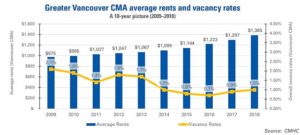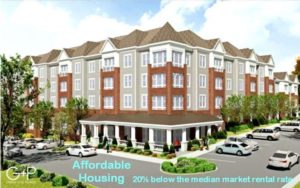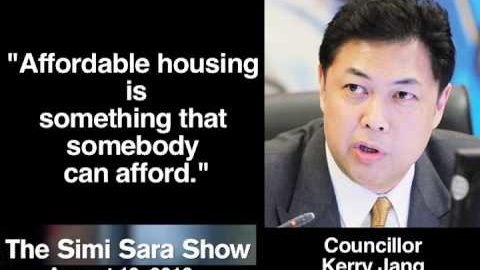
Each year, dating back to 1947, the Canada Mortgage and Housing Corporation …
… a Crown Corporation of the Government of Canada, originally established after World War II to help returning war veterans find housing, CMHC since expanding its mandate to improve Canadians’ “access to housing”, the organization’s primary goals to provide mortgage liquidity, assist in the development of affordable housing, and provide unbiased research and advice to the Canadian government on the housing industry, which as of the second quarter of 2021 had assets in excess of CA$295 billion.
Each October, CMHC sets about to conduct the Rental Market Survey (RMS), during which time the Corporation gathers information on the primary rental market in urban areas with a population of at least 10,000. The primary rental market refers to privately-initiated structures intended to supply the rental market. The RMS specifically targets privately initiated structures with at least three rental units, which have been on the market for at least three months.
The Rental Market Survey is conducted primarily through site visits with the owner, manager, or building superintendent for all sampled structures. From 1996 through 2008, as part of our employment with the Canada Mortgage and Housing Corporation, VanRamblings was tasked with overseeing the collection of rental market information throughout the province of British Columbia, while working with economists employed in CMHC’s Pacific Regional Office to verify the collected information as part of an integrity check.

Vancouver median market rental rate, all bedroom types, 2009 – 2018
When the Rental Market Survey results are published — as early as late November, as late as mid-January — in each metropolitan area across Canada, the median market rental rate in each neighbourhood in each community is determined, and published. What does median market rental rate mean?
“Median Market Rent means the middle value of all monthly rents paid, inclusive of essential utilities, when placed in order of value for a designated market area, and by unit type.”
Let’s use Kitsilano as an example to better explain what is meant by median market rental rate. The October 2021 Rental Market Survey found the median market rental rate in the Kitsilano CMA (Census Market Area) was $1139 per month for a one-bedroom apartment, across all building types and date of construction, recording results in five year increments in buildings constructed from 1975 til now.
In other words, in late 2021, half of those resident in apartment rental accommodation in the Kitsilano CMA were paying less than $1139 each month to rent a one-bedroom apartment, while half of Kits apartment dwellers were paying more. In Kitsilano, as is the case elsewhere across the city, there are those who have been resident in an apartment building dating back to the mid-1970s, and are paying anywhere from $825 to $950 per month in rent.
By the same token, for newer apartment buildings, or in the case of new tenants moving into a vacated apartment, the landlord has seen fit to increase the rent — for say, an unfurnished one-bedroom apartment — to market rental rates as high as $2500 per month, or in some cases even higher.

As former Vision City Councillor Kerry Jang told CKNW talk show host Simi Sara in 2013, “Affordable housing is something that somebody can afford.”
Awhile back, VanRamblings received a call from COPE City Councillor Jean Swanson, who asked us if we’d look into the definition of affordable housing, as it is defined in Metro Vancouver municipalities other than Vancouver. So, we did. This is what VanRamblings found: speaking with administrators in Planning Departments in each Metro Vancouver municipality, be it North Vancouver, Surrey or Port Coquitlam, we learned, in each case, “affordable housing in our community is defined as 20% below the median market rental rate, as determined by CMHC.”
Vancouver, and Vancouver alone, since Kerry Jang’s 2013 statement respecting the definition of affordable housing, has determined affordable housing as NOT 20% below the median market rental rate, but 20% below the market rate. In Kitsilano, to employ that neighbourhood as an example, 20% below the median market rental rate would be an affordable rent of $938 per month, whereas 20% below the current market rate would be $2000 per month — more than double the 20% below Kitsilano’s median market rental rate!

Since being elected to office in 2018, has any — and we mean, any — Vancouver City Councillor sought to adopt the definition of affordable housing, as it applies in every other Metro Vancouver municipality, determinant from the results of the conduct of CMHC’s annual Rental Market Survey? Jean Swanson, maybe? That dissembling “thinks she’s a socialist” saviour of our city (but not really), Christine Boyle?
Christine Boyle and most of Council voted for any and every project that had a so-called affordable rental rate component included. What does that mean in real life?

Let’s take the Jameson Development Corporation project, on the old site of the Denny’s, at Birch and West Broadway. Originally conceived of as a 16-storey purpose-built rental, when the Jameson family made the decision to include a 20% “affordable rental” component, Ms. Boyle and her Vancouver City Council colleagues agreed to allow the developer to build out at a skyscraper-like 28 storeys, in order to deliver 200 market rental homes, with another 58 “homes” to be geared to a person or household earning between $60,000 & $80,000 per year.
Upon completion, a 395 sq. ft one-bedroom on a lower floor of the Jameson project will be marketed at more than $3,000-a-month, which means an “affordable rental” will be available at $2400 each month, or $28,800 annually.
Let’s say you’re a beginning teacher, and you’re earning $60,000 a year. After taxes / CPP / EI deductions, and union dues to pay, in part, for a pension plan and benefits, your total net income would come in at around $45,000, less the $28,800 in rent + utilities — Hydro / Internet / TV / cell phone (say, another $250 a month)— at $3,000, never mind car insurance, gas and car repairs at another $3,000 annually … well, lucky, lucky beginning teacher, s/he will have a grand total of $10,000 remaining to pay for food, clothing, and entertainment — forget about dining out, vacations, never mind birthday presents and Christmas gifts for family and friends.
Nothing like paying 64% of your net income on a 395 sq. ft. supposedly “affordable” apartment on the 5th floor of the Jameson Birch Street project.

In 2022, Vancouver and Vancouver alone continues to define “affordable” as 20% below whatever the market will bear, shutting out tens of thousands of hard working Vancouver citizens — those working at minimum wage, those earning a living wage, or any single person earning the median income of $45,000 — from ever being able to afford to rent within the City of Vancouver.
At the upcoming all-candidates meetings in September, ask all those who are running for office to become a Vancouver City Councillor whether they will commit to ensuring that affordable housing in Vancouver is redefined as 20% below the median market rental rate as determined by CMHC’s annual Rental Market Survey.
And while you’re at it, ask these prospective candidates whether they will move to have rents in apartment buildings tied to the current rental rate — through a change to the Vancouver Charter — so when a tenant moves out, the owner / landlord can’t raise the rent to an unaffordable market rental rate.
One more thing: ask these prospective Vancouver City Councillors whether they’ll move to adopt Burnaby and New Westminster’s demoviction bylaw.
- An affordable housing plan. The revival of the Community Land Trust relationship between Vancouver City Hall and the Co-operative Housing Federation of B.C., that would see the construction of 1500 new housing co-op homes built each year on city, provincial and federal Crown land, each of the next four years. An affordable housing plan that would expedite the construction of ten 150-unit family housing co-ops each year — think the City Gate Housing Co-operative on Milross Avenue, the Roundhouse Housing Co-operative on Marinaside Crescent, in Yaletown, or the Railyard Housing Co-operative on Quebec Avenue at 1st, due east of the Olympic Village — all built at no expense to Vancouver citizens — while foregoing the $1 million in development permit fees. Construction and materials cost: paid for through a combination of mandated developer Community Amenity Contributions and provincial and federal funds (both Prime Minister Trudeau and former B.C. Housing Minister, David Eby, have signed off on the above). Cost to Vancouver citizens: zero. Cost of land: zero. Cost to Vancouver citizens for construction and materials: zero. A negotiation with the federal government would ensure that all subsidy monies for Co-op members would be paid for through the federal co-op housing subsidy fund. All monies paid by Co-op residents — after administrative, amenity payments and maintenance costs, and monies placed into a “replacement reserve fund” for major, future renovations — would be returned to the City to build supportive social housing, at no cost to citizens.
You’ve got your work cut out for you over this next six weeks, as you and your neighbours hold those who would wish to be elected to City Council to account. Are these candidates for Council on your side, or are they on the side of an unacceptable status quo or worse, greed-oriented and deep in the pockets of the developers who are funding their campaigns for office?
